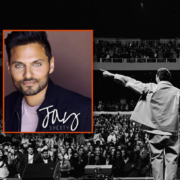New Study Reveals the Social Realities of Indian Americans Including Caste-Based Identity, Religion and Marriage
- Roughly half of all Hindu Indian Americans identify with a caste group. More that eight in ten Hindus with a caste identity, identify themselves as belonging to upper caste category.
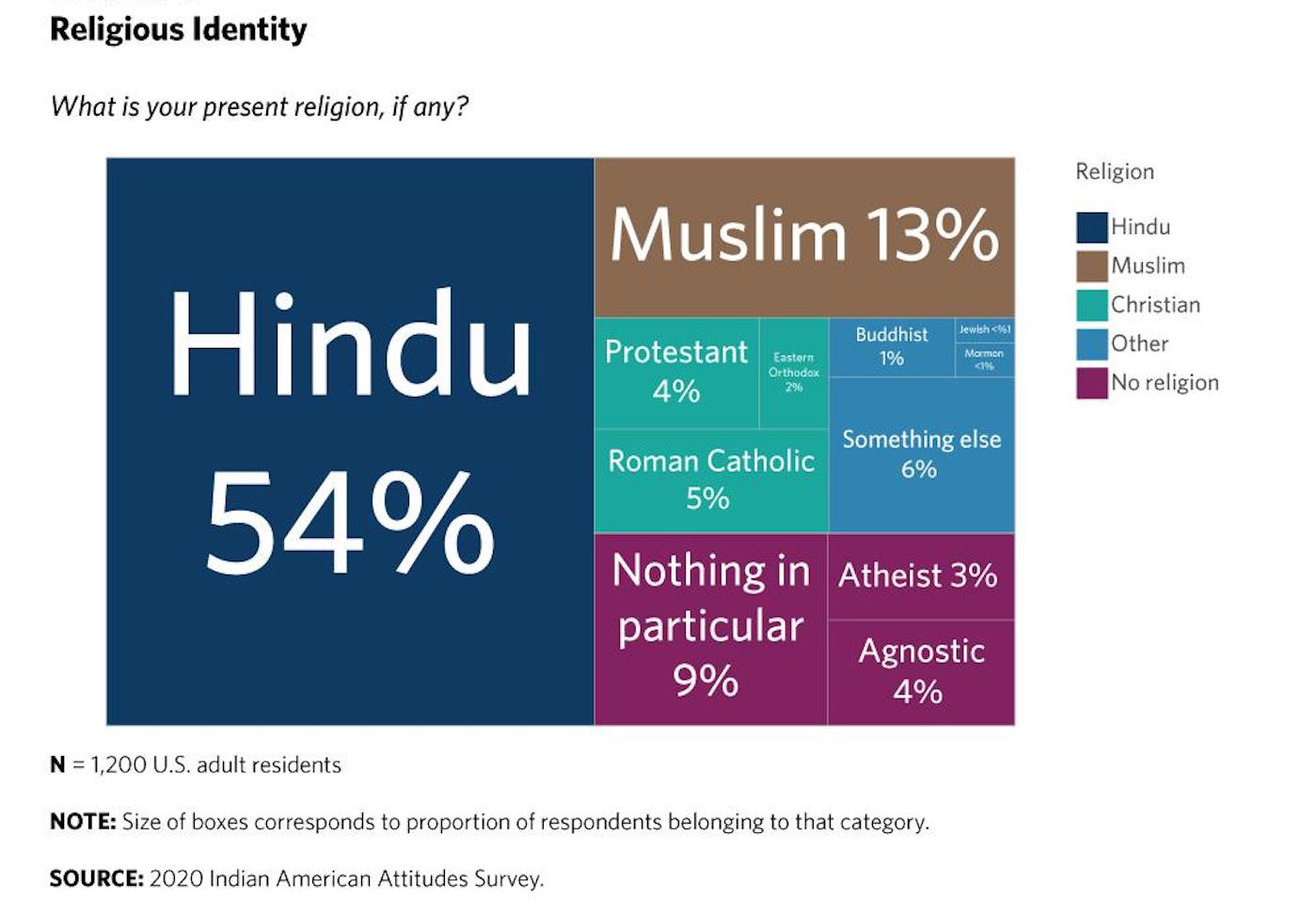
Fifty percent of Indian Americans have been discriminated against in the past year alone. While Indian Americans regularly encounter discrimination, in the past year, during the height of the COVID-19 pandemic, one in two Indian Americans reported being discriminated against. Discrimination based on skin color identified as the most common form of bias.
Somewhat surprisingly, Indian Americans born in the United States are much more likely to report being victims of discrimination than their foreign-born counterparts. However, when asked to compare discrimination towards their community with that of African Americans, Hispanics or Asian people, 52 percent of Indian Americans believe that people here discriminate more against all of the other minority groups than they do against Indian Americans.
This is one of the key findings of a study on the social, political, and foreign policy attitudes of Indian Americans co-authored by Sumitra Badrinathan, Devesh Kapur, Jonathan Kay, and Milan Vaishnav.
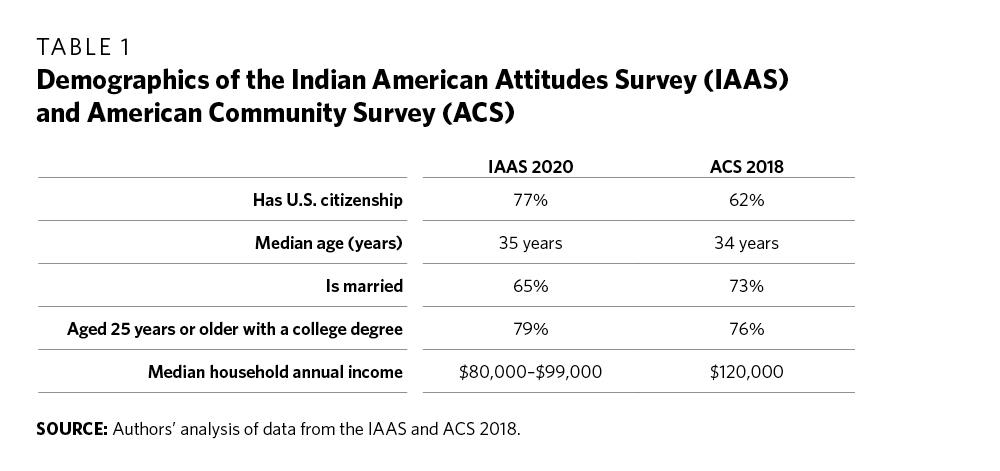
Calling the findings on the increase in discrimination within the community as “the headline finding of the report,” Vaishnav told American Kahani that the revelation comes at a time when there’s a spotlight on Asian Americans as the community faces violence and discrimination. “Although Indian Americans do not appear to be among the primary targets of this violence—as they were in the aftermath of the September 11, 2001 terrorist attacks—the disquieting crime wave has cast a spotlight on the bigotry and violence many Asian immigrant populations experience in this country,” he says. As the common form of discrimination most Indian Americans face is due to the color of their skin, Vaishnav says it shows that “in the U.S., race is a major divider, and it extends to the Indian community.” Vaishnav is a senior fellow and director of the South Asia Program at the Carnegie Endowment for International Peace.
The issues addressed in the study show that Indian Americans, who are the second-largest immigrant group in the U.S., are not inoculated against the forces of discrimination, polarization, and contestation over questions of belonging and identity, despite the overall professional, educational, and financial success many in the community may enjoy.
According to data from the 2018 American Community Survey (ACS)—which is conducted by the U.S. Census Bureau—there are 4.2 million people of Indian origin residing in the U.S.. Although a large proportion are not U.S. citizens (38 percent), roughly 2.6 million are (1.4 million are naturalized citizens and 1.2 million were born in the United States).
Identity Based on Caste
The survey also questioned the respondents on caste, a sensitive and controversial topic in the Indian American community. Media reports about caste discrimination in companies located in California’s Silicon Valley, which employ a large number of Indian Americans — was one of reasons the issue of cate was brought to the forefront. Another incident that highlighted caste in America was the controversy over whether caste should be a part of history textbooks in the state of California.
Vaishnav says the data from the survey will help them find out the extent of the identification of caste and discrimination based on it. The survey revealed that roughly half of all Hindu Indian Americans identify with a caste group. More that eight in ten Hindus with a caste identity, self-identify as belonging to the category of general or upper caste, the survey notes, adding that foreign-born Indian Americans are significantly more likely than those born in the U.S. to espouse a caste identity.
“Even if only half of the Hindu Indian Americans identify with caste, there are several social settings where caste plays a role, where people are aware of the caste of those they are socially connected with. So caste plays a role in the background, and in the forefront” Vaishnav notes.
However, he adds that when it comes to discrimination based on caste, less that 5 percent of those surveyed said it was a factor. “Caste is the least common factor on which Indian Americans have been discriminated,” he notes, adding: “Skin color and country of origin play a larger role.”
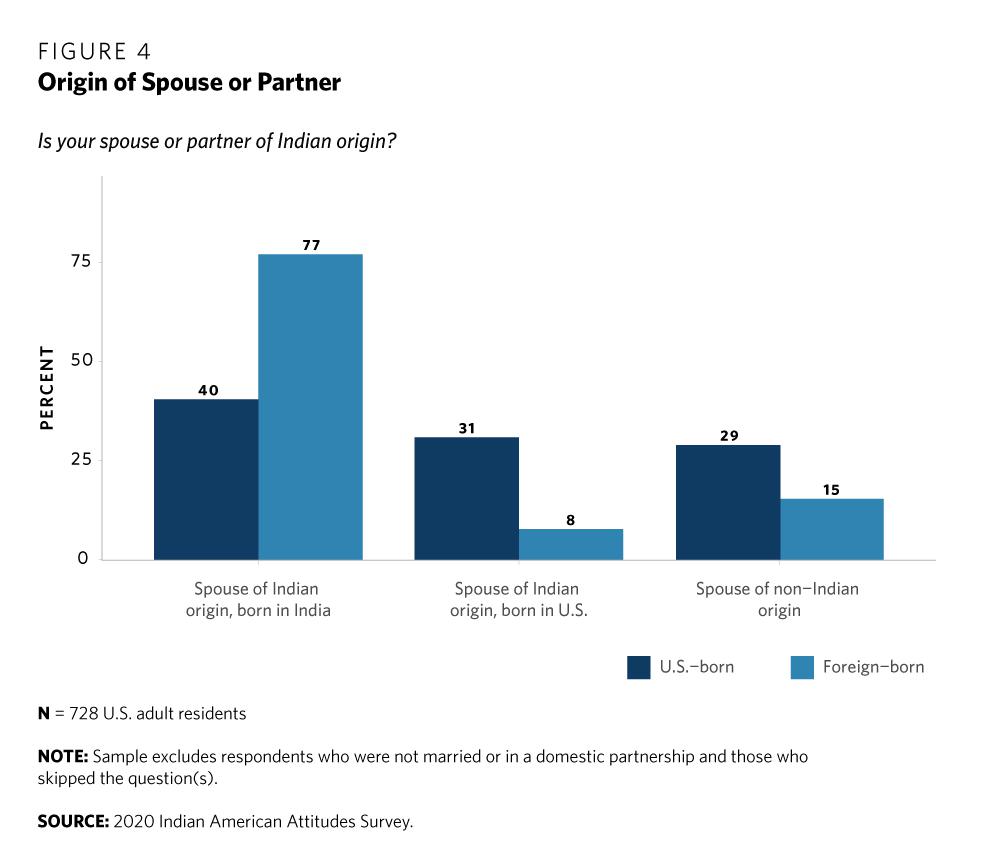
The report cites the Cisco case that brought cast-based discrimination in corporate America. In 2020, California’s Department of Fair Employment and Housing filed a lawsuit against the technology company Cisco Systems after an employee from one of India’s historically marginalized caste communities (“Dalits”) alleged that some of his upper caste Indian American colleagues discriminated against him on the basis of his caste identity. The lawsuit and the media coverage triggered a wave of wrenching testimonials about the entrenched nature of caste within the diaspora community – at work places and educational institutions.
Authors note in the study that “while caste is most commonly associated with Hinduism, caste hierarchies and caste self-identification are prevalent in most, if not all, of India’s major religions. For instance, the category Other Backward Classes (OBC) is common among Muslims, while Scheduled Castes or Dalits can also be found in Buddhist, Sikh, Christian, and Muslim communities.”
Multiple Identities
Vaishnav says the respondents included longtime immigrants, recent immigrants, those born and grouped up here as well as those on work visas. Questions like the importance of being an Indian to their identity or their civic and political engagement depended on who was replying. Eighty-three percent of foreign-born Indian Americans said being Indian is either very or somewhat important to their identity, compared to 70 percent of U.S.-born Indian Americans.
“The differences are most pronounced among those who say being Indian is very important to them,” Vaishnav notes. On the other end of the spectrum, 30 percent of Indian Americans born in the United States answer that being Indian is either somewhat or very unimportant to their identity—a response given by just 17 percent of foreign-born Indian Americans. When it comes to civic and political engagement and involvement,” Vaishnav says “U.S.-born citizens are the most engaged, followed by foreign-born Indian Americans. Non-citizens work visas like H-1B are the least engaged.”
The same pattern can be seen in topics like religion and marriage. Religion plays a central role in the lives of Indian Americans but religious practice varies, the study found out. “While nearly three-quarters of Indian Americans state that religion plays an important role in their lives, religious practice is less pronounced.” Forty percent of those surveyed pray at least once a day and 27 percent attend religious services at least once a week.
When it comes to marriage, the study noted that Indian Americans exhibit very high rates of marriage within their community. “While eight out of ten respondents have a spouse or partner of Indian origin, U.S.-born Indian Americans are four times more likely to have a spouse or partner who is of Indian origin but was born in the United States.”
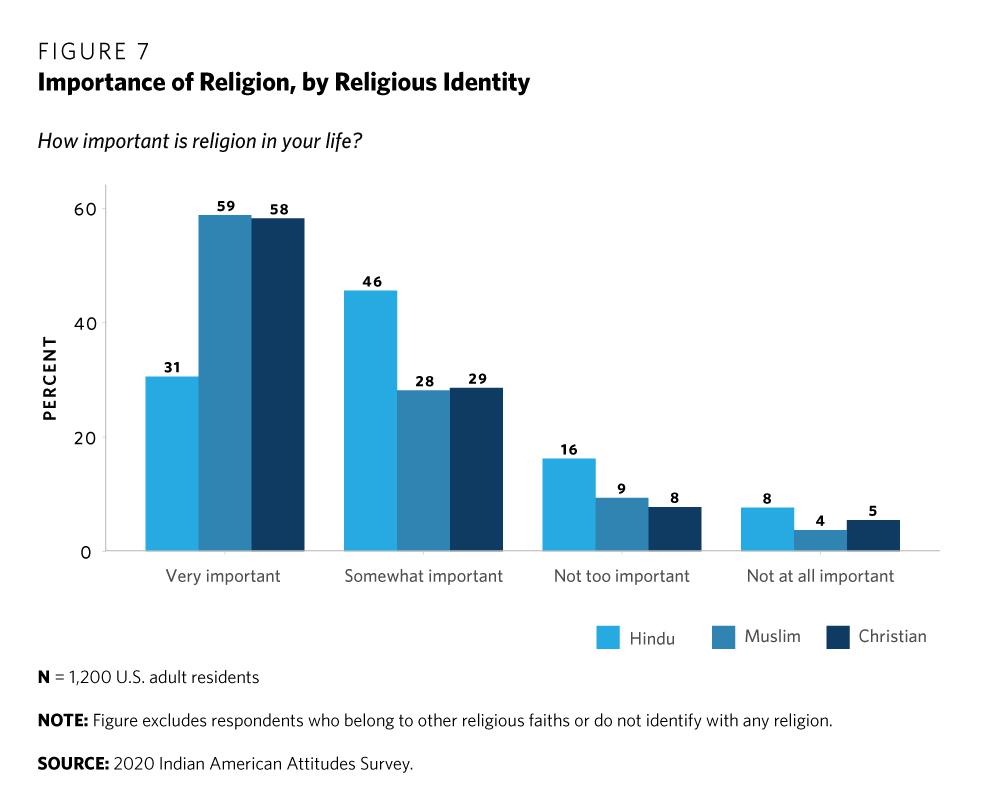
While socializing, Indian Americans—especially members of the first generation—tend to socialize with other Indian Americans. “Internally, the social networks of Indian Americans are more homogenous in terms of religion than either Indian region (state) of origin or caste,” the authors say.
According to IAAS data, 54 percent of respondents said they were Hindu, while 16 percent claimed no religious affiliation (a category that includes agnostics and atheists). Thirteen percent of respondents are Muslim, 11 percent are Christian, and another 7 percent belong to a variety of other faiths including Buddhism and Sikhism.
Indian American Identity
Respondents were questioned on the usage of the term Indian Americans. “Not everyone embraces that term,” Vaishnav notes, adding that “a smaller share preferred to be referred to as South Asian Americans,” signifying solidarity with other groups hailing from the subcontinent. The study describes the term Indian American as “a commonly used shorthand to describe people of Indian origin. As per the study, only four in ten respondents believe that “Indian American” is the term that best captures their background.
Authors provide a little story on the identification challenges the Indian American community has faced over the years. “The official classification and self-identities of the Indian American community have posed a conundrum for more than a century,” the authors say, from “Hindoo” to “Asian” to “South Asian” to “Asian Indian” to “Indian American” to “American.” There are others that “reject hyphenation entirely,” preferring to be known simply as “American,” authors note.
They give an example of former Louisiana governor Bobby Jindal, who declared in 2015 that he “does not believe in hyphenated Americans. . . . My dad and mom told my brother and me that we came to America to be Americans. Not Indian-Americans, simply Americans.” A year earlier, Around the same time, Nina Davuluri, who was crowned Miss America 2014, remarked, “The fact that I am rooted in Indian culture helped me win [the] Miss America pageant.”
Divisions Within
Another significant finding of the study is regarding the polarization among Indian Americans, which the authors says reflects broader trends in American society. “While religious polarization is less pronounced at an individual level, partisan polarization—linked to political preferences both in India and the United States—is rife,” the authors say. However, this polarization is asymmetric, they add.
The study finds that Democrats are much less comfortable having close friends who are Republicans than the converse. The same is true of Congress Party supporters vis-à-vis supporters of the Bharatiya Janata Party (BJP). “To some extent, divisions in India are being reproduced within the Indian American community,” the study says. While only a minority of respondents are concerned about the importation of political divisions from India to the United States, those who identify religion, political leadership, and political parties in India as the most common factors.
Indian American Attitudes Survey (IAAS) is a collaboration between the Carnegie Endowment for International Peace, Johns Hopkins-SAIS, and the University of Pennsylvania. Authors say 1,200 Indian American adults participated in an online survey, conducted between Sept. 1 and Sept.20, 2020, in partnership with YouGov. The survey has an overall margin of error of +/- 2.8 percent.


